Oswego’s downtown business district originally catered to the agricultural area surrounding the village as well as to in-town residents. That meant it contained a mix of stores that met virtually all the needs of those residents, from general merchandise to groceries to boot and shoe makers to hardware and harness stores to auto dealerships.
Gradually, however, as transportation options expanded and became more efficient and less expensive and time consuming, the mix of retail stores began changing. The traditional mix of retail stores changed as village residents began preferring to do their shopping at larger stores farther afield. One by one, the original mix of stores changed until the current mix of specialty shops and eating establishments was reached.
A good illustration of this changeover, which began more than 60 years ago, is the disappearance of Oswego’s downtown grocery stores. Throughout the first half of the 20th Century, Oswego always supported at least two downtown grocery stores. As the 1960s dawned, those stores were run by Wayne Denney and Carl Bohn. By the middle of that decade, Denney’s store was closed and Bohn’s was run by his son, Kenneth, who would hold on until the summer of 1981.
The roots of the Bohn family’s participation in Oswego’s grocery business extended back into the late years of the 19th Century and offer a good illustration of how small-town business conditions changed through the years.
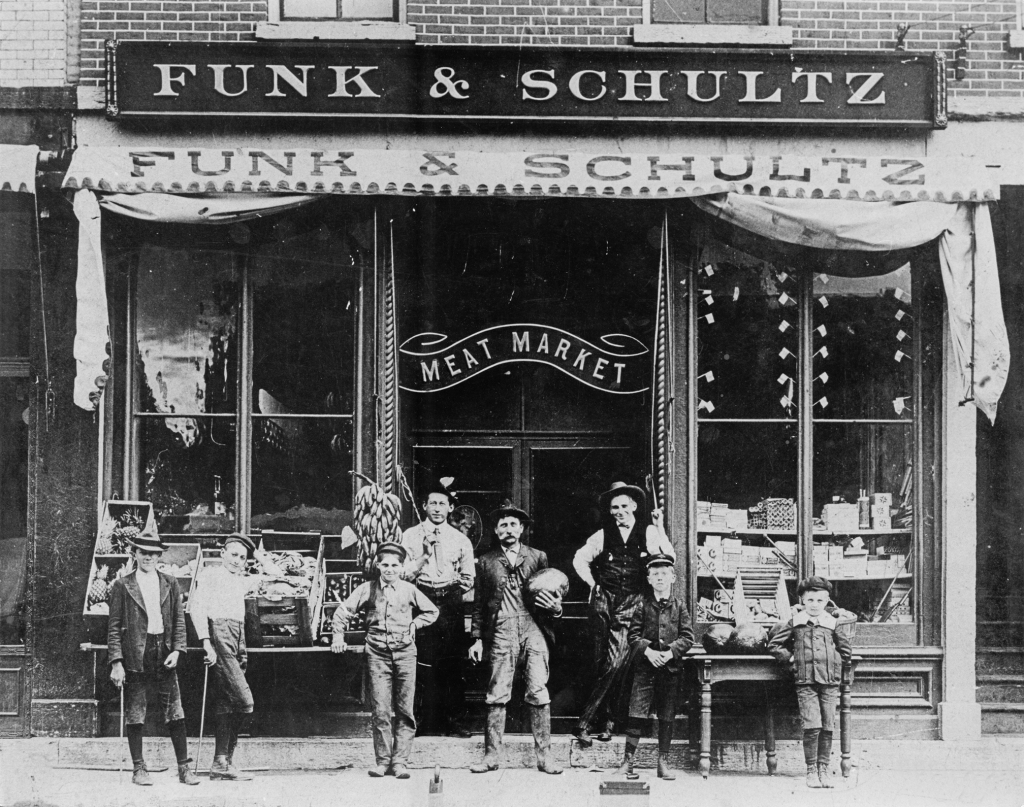
Young Charles Schultz who had come to this country from Germany with his family, began working in the William Funk grocery store, located in one of the mid-storefronts of Oswego’s Union Block in 1895. He was just 12 years-old at the time.
Funk owned a number of downtown Oswego properties and in August 1902 he bought what was known as the Wilcox Building in the brick Union Block on the east side of Main Street and opened a new grocery store there. A month later, Schultz bought into a partnership with Funk, and the firm became known as Funk & Schultz.
As the Kendall County Record reported on Sept. 17, 1902: “Funk & Schultz constitute a new firm of the Oswego business, which is on opening a grocery store and meat market in the orange-colored building of the east side brick block.”
In August 1904, Schultz sold his interest in the business to Funk and opened his own grocery store in Montgomery. Funk, then, bought the Schultz Montgomery business in May 1907. In August 1908, Schultz moved back to Oswego and bought Will Miller’s hardware store.
The next month, the Record reported that Charles Schultz’s brother was going into business in the hardware store, too: “Layton Lippold and Richie Schultz are to open a grocery store in part of the store room now occupied by Schultz’s hardware store.”
In March 1910, Charles Shultz bought out Layton Lippold’s interest in their Oswego hardware store. And that September, the Record’s Oswego correspondent reported that Schultz was branching out of the hardware business: “Charles Schultz and Ben Leigh are having the Shoger building, formerly occupied by A. Flagg as a pool hall room, remodeled for a bowling alley, which they will conduct this winter. Three alleys with modern improvements will be installed.” It was the start of a dizzying group of business changes in which Schultz was involved.
In March 1912, Schultz’s business changed again, according to the Record’s Oswego correspondent: “March 1 witnessed a change among our business houses when Charles Schultz sold his groceries and hard ware stock to his brother, Richard, and Mr. Van Valkenberg, who will continue the business. Mr. V., with his family, recently moved from Aurora to the Barker tenant house.” The new firm was known as Schultz & Van.
But by January 1913, Charles Schultz was back in business in Oswego, this time with his brother Richard, the Record noting on Jan. 1 that “Paul Dwyre has resigned his position with Schultz Brothers & Co.”
As a sidelight, a short note in the Nov. 25, 1913 Kendall County Record reported that some Oswego businesses—especially the village’s grocery stores—were planning to be open Thanksgiving Day morning for the convenience of late shoppers. “Do your Thanksgiving trading early; H.B. Read, Schultz Bros. & Co. and Wm, Morse close their stores at 10 o’clock Thursday morning,” the Record’s Oswego correspondent noted.
Charles Schultz was not only a successful businessman, he was also an early adopter of technology, especially the newly perfected automobile. He owned his own, and also participated in auto trips with other Oswego enthusiasts. A May 5, 1915 Record article reported: “Sunday, in spite of threatening weather, Messrs. L.P. Voss, G.H. Voss, E.A. Smith, Charles Schultz, Charles Cherry, and Lyman Pearce left at an early hour by automobile across the country. Their first stop of importance was Sycamore, where they breakfasted. Enroute they visited Belvidere, Rockford, Oregon, Grand Detour, where dinner was enjoyed, then on to Dixon, Mendota, LaSalle, Peru for supper, Ottawa, and back to Oswego. Leaving Oswego at 6 a.m. and arriving at home at 12 midnight, covering a distance of 230 miles is a very unusual record. Muddy roads were encountered, but the grand scenery along the Rock River left the muddy roads behind. Lyman Pearce drove the car.”
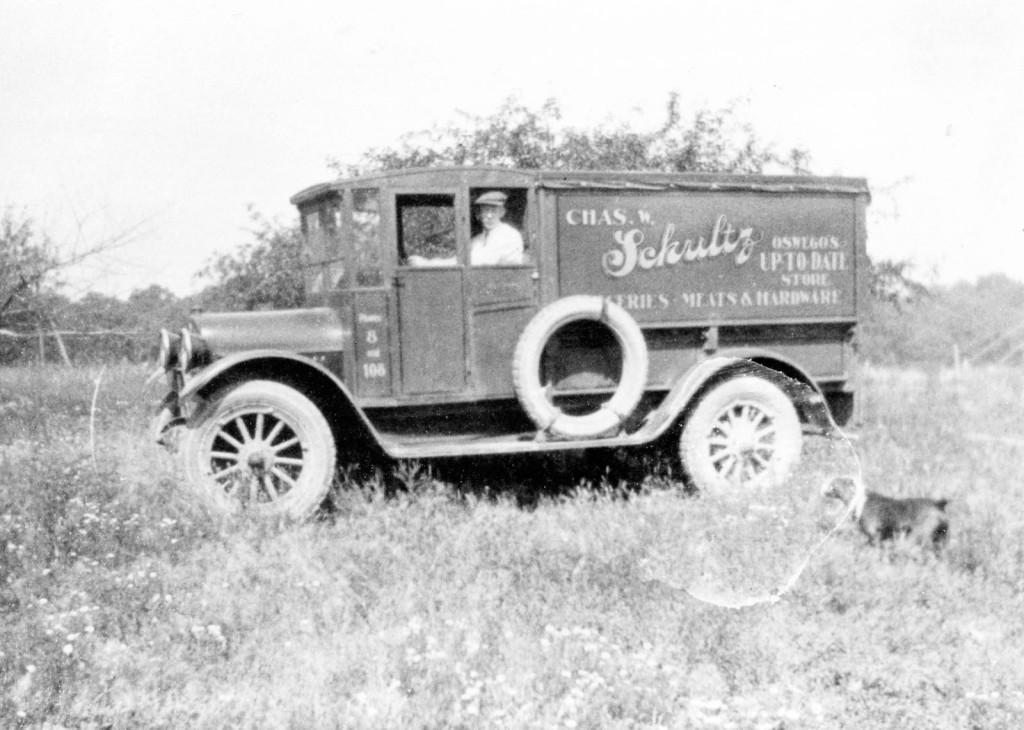
Schultz Brothers had regularly delivered groceries to their Oswego customers in a horse-drawn delivery wagon. But in October 1915, the brothers’ interest in technology led to a change. According to the Oct. 20, 1915 Record: “Schultz Bros. & Co. have recently purchased an auto delivery truck.”
Then on Dec. 29, 1915, the Record reported a major business change in Oswego: “J. P. Schickler has sold the building he has been occupying [at the northwest corner of Main and Washington streets] to Messrs. Charles and Richard Schultz, who will move their present business to that location, occupying the living rooms above the store building. The J.P. Schickler family will move to the Todd house.”
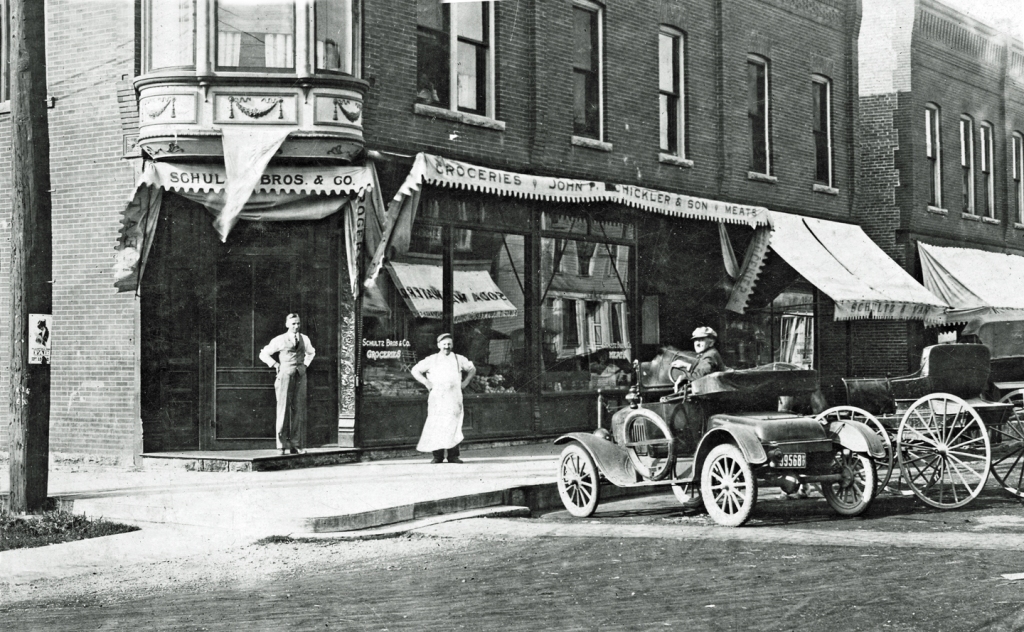
On Jan. 5, 1916, the Record added: The company of Schultz Bros. recently purchased the John Schickler block and is now moving grocery and meat departments to that location. The barber shop will be transformed into a hardware store extending to the rear of the building. Mr. Charles Schultz will move into the rooms vacated by Andrew Swanson. An unusually attractive corner is being made by the company and one of the most metropolitan stores in the county.”
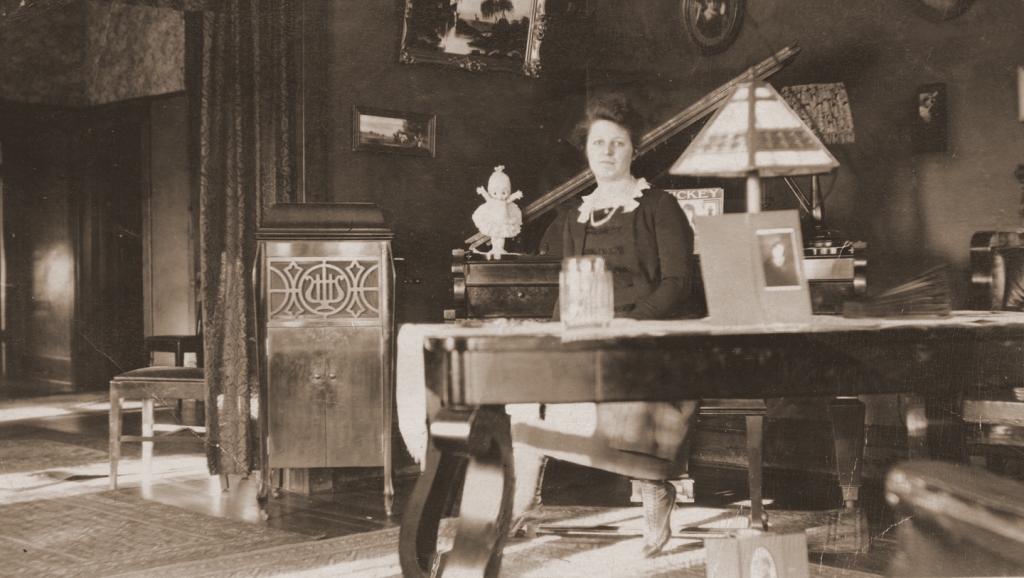
By Jan. 12, Charles Schultz and his wife had moved into the apartment above the grocery store.
Schultz continued to innovate. In 1920 he installed a modern refrigeration unit in the store and in 1923 he bought a new REO Speed Wagon delivery truck to replace the old truck purchased nearly a decade earlier.
Richard Schultz left the business in 1921 and moved to Indiana. In 1923, Robert Peterson briefly partnered with Charles Schultz, the business named Schultz & Peterson. But the partnership didn’t last long, and Schultz was soon in business by himself.
In 1921, young Carl Bohn joined Schultz’s business as a clerk and stockboy. Carl Bohn was born July 14, 1906 in Milwaukee, Wisconsin, the son of Charles and Augusta (Schultz) Bohn. The family moved to Oswego a few years after Carl was born.
In 1929, Carl married Cecil Bangs, the Kendall County Record noting in their May 1 edition: “Mr. and Mrs. Carl Bohn are located in the apartment over Schultz’s hardware store. Congratulations to the newly-weds.”

Bohn worked for Schultz for more than two decades becoming a valued employee and almost a partner in the business. Like Schultz, Bohn became a fan of the early adoption of technology to add profits to their grocery business. For instance, in 1940, Schultz added the then-new concept of selling frozen foods from their Oswego store. The Kendall County Record reported on April 10 of that year: “If you want to see something good to eat, just step into the Schultz grocery store and ask to see the frozen foods he has on display.”
Then in 1946, immediately following the end of World War II, Charles Schultz decided to retire.
The April 3, 1946 Record reported from Oswego: “Carl Bohn and his brother-in-law, Marion Bangs, have purchased the Charles Schultz grocery business, and took possession April 1. Mr. Bohn has been employed in the store for 25 years. Mr. Bangs, formerly a farmer in Iowa, and his wife will move to Oswego when they can find a home. He is a pleasant fellow and will be a welcome addition to the businessmen of Oswego. The same line of good groceries, meat and frozen foods will be carried by the new firm. Mr. Schultz, who is retiring until he has had a good vacation, has been in the grocery business for 51 years, clerking when only a schoolboy and having his own business for 35 years.”
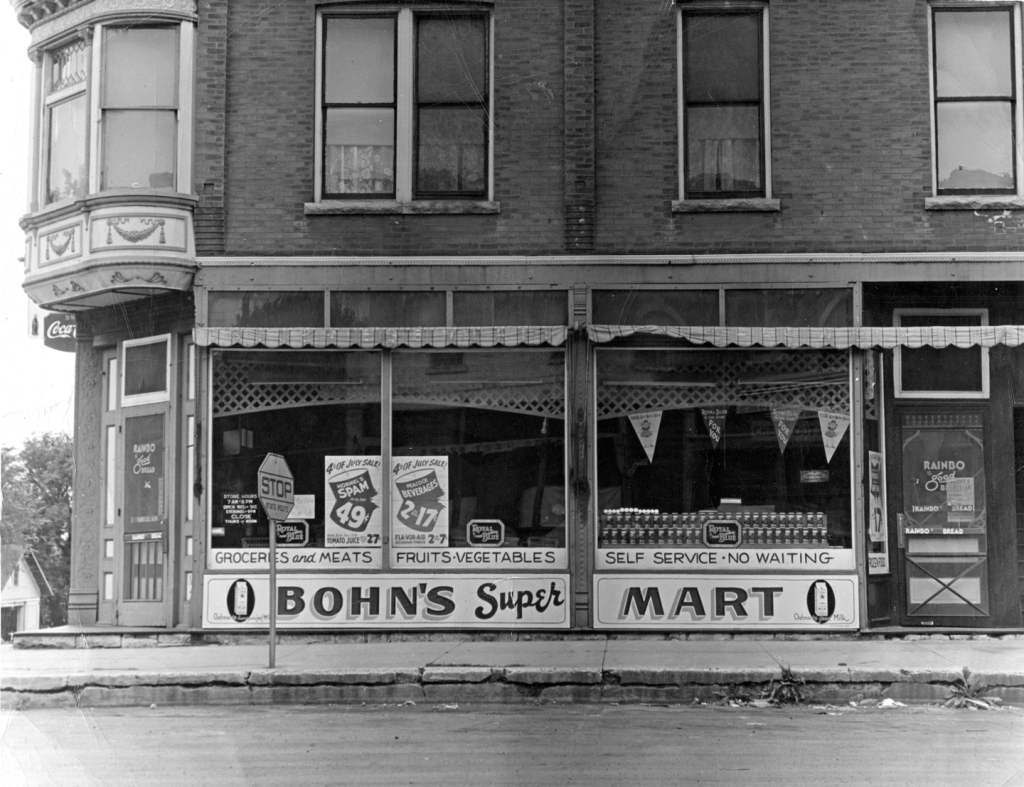
The Bangs partnership didn’t last long, however, and Carl Bohn continued the business on his own. And that included expanding the business. In 1953, he announced plans to build a new, modern grocery store on the east side of Main Street on the lots where the old National Hotel once stood at 60 Main Street. The hotel had been destroyed by fire in 1867 and never rebuilt. Since that time, a number of businesses had come and gone in that location, but by 1953, the lots there were vacant.
Construction, with Oswegoan Harold Van Etten serving as general contractor, began in the fall of 1953. By Dec. 10, Ford Lippold’s Oswego Ledger could report: “Bohn’s new store is under cover and a lot of concrete was poured for the new fire barn last week.”

On March 18, 1954, Bohn’s took out an Oswego Ledger ad stating: “Having outgrown our present location, we are building and bringing to Oswego a new, completely modern store with each department bigger and better designed to serve your needs including meat, groceries, produce, and frozen foods, which will open soon,”
Then on April 8, the Ledger reported: “The new Bohn’s Grocery Store holds its grand opening this week with special entertainment and special sales. The store, located in Main Street, is of cement block construction with a brick front. Has a big well-planned interior with the latest and most modern fixtures. Among the many opening features will be the violin playing of Jim McGlue all day Friday, the organ music of Lorane Peshia Wednesday and Thursday evenings, and the arrival of Little Oscar and his Wienermobile on Saturday afternoon.”

The Bohns continued to run the store and engage in community activities. In 1958 when Oswego Township marked the 125th anniversary of its settlement with its “Oswegorama” celebration, Bohn’s again sponsored an appearance by Little Oscar at his store in downtown Oswego and the Oscar Meyer Wienermobile in the huge Oswegorama parade.
By the early 1960s, competition with the growing number of chain grocery stores meant cutting some services, like going to customers’ homes to take their orders and then delivering them later the same day, had to be dropped. And although he wasn’t all that old, Carl Bohn’s health began to wane. In 1963 he sold the store to his son, Kenneth.
Carl Bohn died in January 1964 at the age of 57—his wife, Cecil, lived until 1987 and continued helping in the store until it closed—but with son Kenneth then running the business, the store still tried its best to serve its local customer base. Kenneth continued the tradition of innovation. In November 1965, Oliver Pierce opened an expanded meat market in Bohn’s Food Store and Bohn’s added an expanded bakery department next to Pierce’s meat counter.
But by the 1970s, it was clear the era of small-town grocery stores was coming to a close. Denney’s Supermart just down the block from Bohn’s, had closed in 1967, leaving Bohn’s as Oswego’s only grocery store.

“Although we had many personalized services that large discount stores do not offer, the changing times and shopping habits, combined with poor parking and the trend away from independent stores left no future for the business,” Gertrude Bohn noted.
So in 1981, Kenneth Bohn made the decision to close the family store, ending a tradition that began so many decades ago when Charles Schultz became a fixture in Oswego’s downtown business district. The store’s last day was July 31, 1981, ending an era of grocery stores in downtown Oswego that extended all the way back to the village’s founding in 1835.
Oswego dentist Dr. David Cinto bought the 60 Main Street building from Bohn and moved his dental practice there, along with a couple of other professional offices. It has continued to be a fully occupied business location in the heart of Oswego’s business district to the present day.
